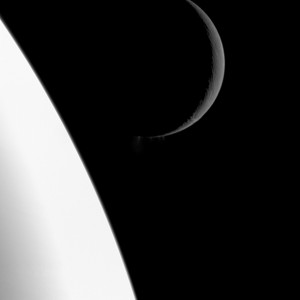Like any scientist, I love a good mystery. Sometimes it’s fun when they are long, complicated, involve subtle and difficult layers, and require a vast effort to unravel.
And sometimes it’s cool when they are simply stated and simply solved. Like asking “Where does the water in Saturn’s upper atmosphere come from?” and finding out the answer is “It rains down from the moon Enceladus.”
Water has been seen deep in Saturn’s atmosphere before, but a few years back it was detected in the upper atmosphere as well, and that’s a bit weird; there don’t appear to be any ways to get it from deep down in Saturn to the top parts of its clouds. So how did it get there?
Well, the tiny, icy moon Enceladus was discovered to have geysers at its south pole, actively spewing out quite a bit of water into space. Most of it goes into space and is gone forever. Some actually forms a ring around Saturn called the E-ring, and some no doubt hits other moons. Generally, when a moon blasts stuff into space (like Jupiter’s moon Io does with its sulfur volcanoes) the material forms a big donut-shaped region around the planet. It was figured that Enceladus was doing the same thing with water around Saturn, but even the Cassini spacecraft, which is right there, couldn’t detect it. It’s pretty hard to sample.
But astronomers used Herschel, an Earth-orbiting infrared observatory, to observe Saturn. They found a peculiar feature in the infrared spectrum of Saturn, and realized it’s from this Enceladusian water torus. Apparently, about 3-5% of the water from Enceladus’s geysers falls on Saturn, literally raining down in sufficient quantities to explain the presence of the water detected in the ringed planet’s upper atmosphere.
It’s pretty rare to be able to say this confidently in science, but: case closed.
 Mind you, I’m not an expert on Saturn, but I read the scientific paper published (PDF) and it looks pretty good. They find that about 2.5 x 1026 molecules of water fall onto Saturn every second, which sounds like a lot until you remember a molecule is pretty small. Reaching back into my dim memories of high school chemistry, I get that this equals about 7.5 kilograms (roughly 17 pounds) of water rain falling onto the planet every second*. That’s not a whole lot! Saturn’s a big planet, and that translates to about 600,000 molecules falling per square centimeter every second.
Mind you, I’m not an expert on Saturn, but I read the scientific paper published (PDF) and it looks pretty good. They find that about 2.5 x 1026 molecules of water fall onto Saturn every second, which sounds like a lot until you remember a molecule is pretty small. Reaching back into my dim memories of high school chemistry, I get that this equals about 7.5 kilograms (roughly 17 pounds) of water rain falling onto the planet every second*. That’s not a whole lot! Saturn’s a big planet, and that translates to about 600,000 molecules falling per square centimeter every second.
In a heavy rainstorm on Earth, you get about 1 inch of water an hour falling down. That’s .0007 grams/second falling on a square centimeter of ground, so the rain on Earth is roughly 42 trillion times heavier than on Saturn. I don’t think you’ll need an umbrella if you visit.
Of course, whenever you solve a mystery, another opens up. It’s known that Saturn’s giant moon Titan has water in its upper atmosphere as well. According to the astronomers who made these observations, their models show that the rain from Enceladus onto Titan is not enough to account for what’s seen there; they’d need 5 - 20 times as much water to explain Titan. So clearly there must be some other source of water for that, and whatever it is it doesn’t reach Saturn or else more water would be seen there as well.
What could it be? No one knows.
Did I say, “Case closed”? Yeah, honestly, you can never say that in science. That’s why it’s fun!
Images credit: NASA/JPL/Space Science Institute
* There are 6.02 x 1023 molecules in a mole (from Avagadro’s number), and water has a mass of 18 grams per mole. The rest is just multiplication and division. I’ll note in the original version of this post I used the wrong number for Avagadro’s number, so I simply corrected the numbers above.
Related posts:
- Enceladus sprays anew
- Enceladus on full afterburner
- Enceladus is erupting!
- Season’s E-rings